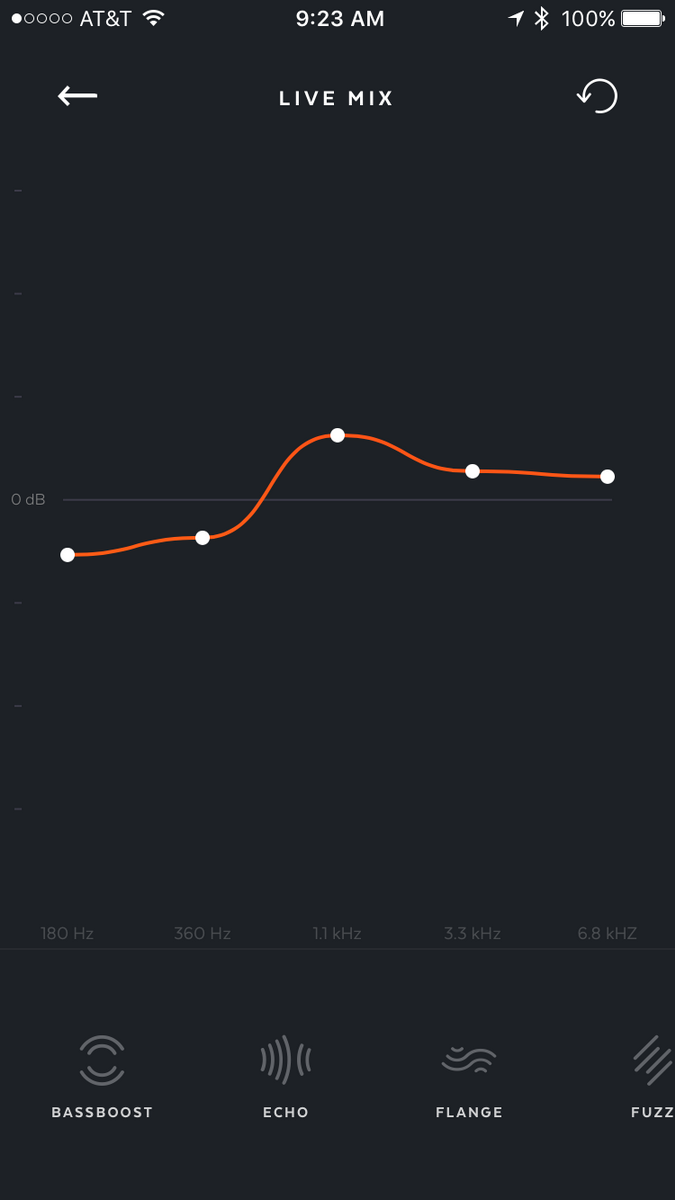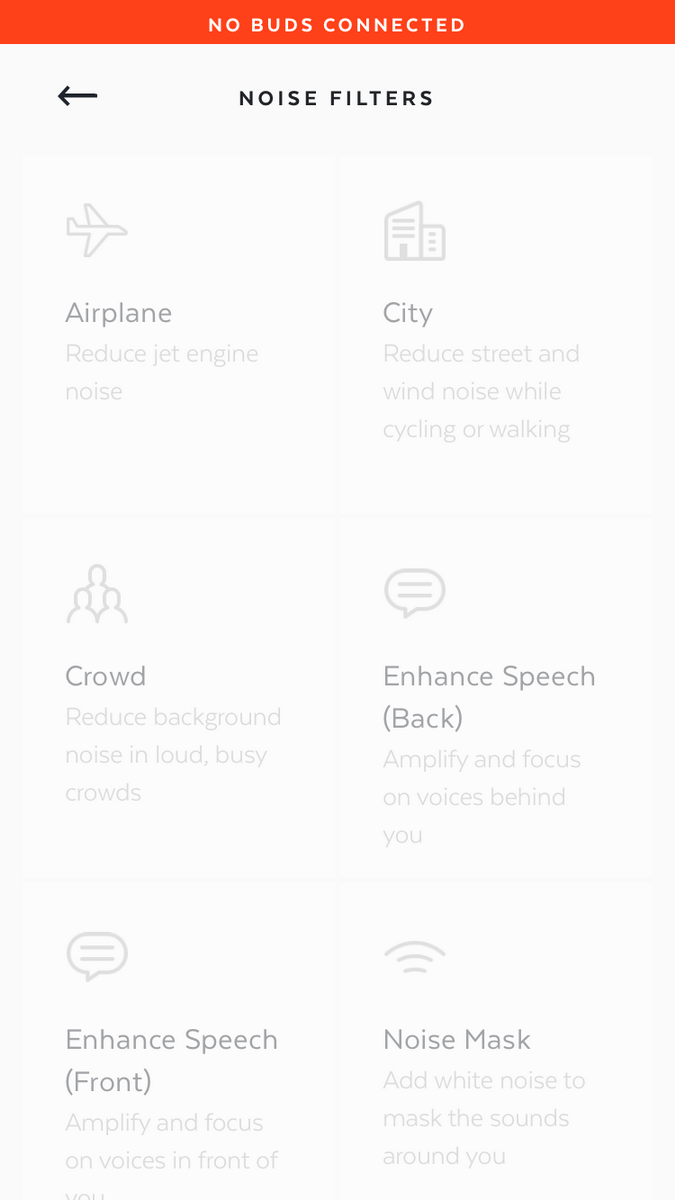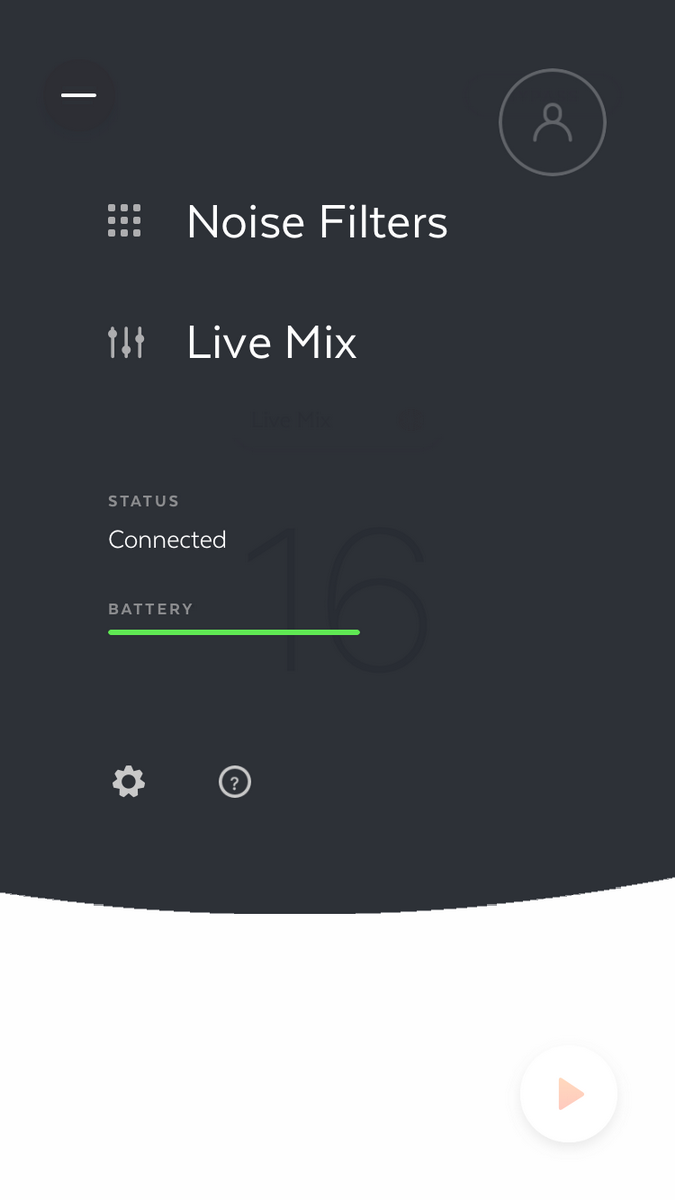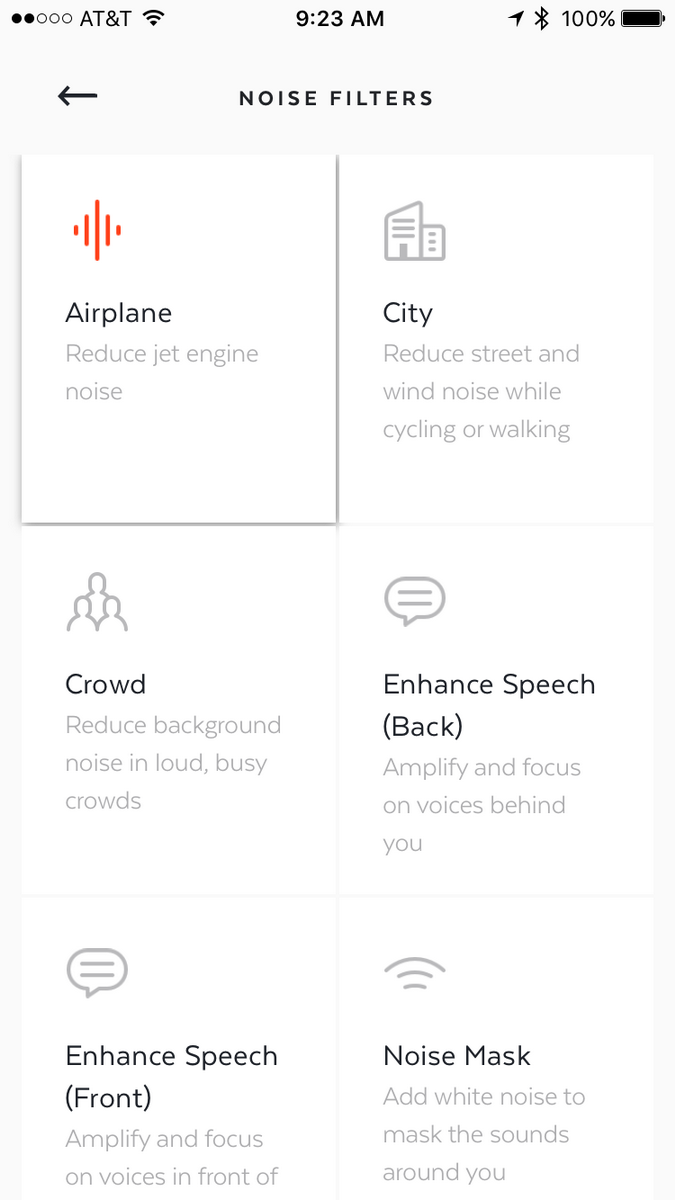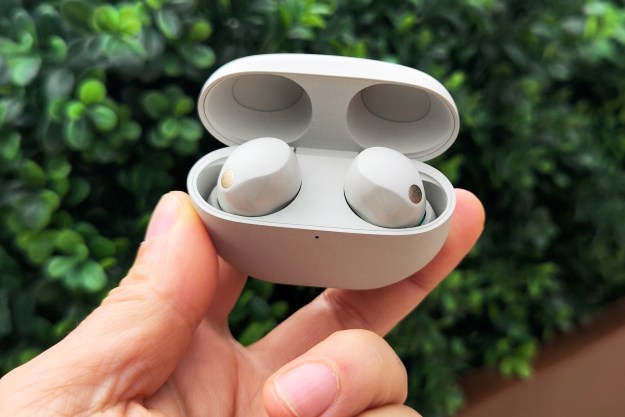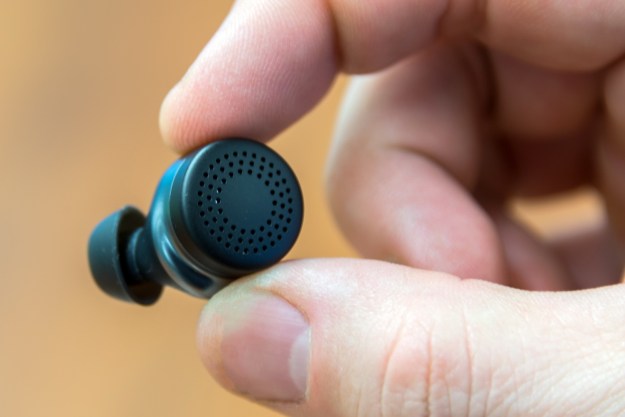
“Doppler Labs’ new Here One let you alter your sonic world inside and out, but only for a few hours at a time.”
- Warm, and detailed audio performance
- Filters cut through noise in multiple settings
- Light and relatively comfortable
- Ability to EQ live sound
- Quick charging
- Battery life a real constraint
- Occasional Bluetooth quirks
- Airplane noise cancellation just ok
Update: On November 1, 2017 Doppler Labs CEO Noah Kraft announced the company will be going out of business. The company has released one final update to the Here One app aimed at the hearing impaired, but its doors will be shuttered as of November 10, with minimal support continuing through the end of the month.
Doppler Labs came out of nowhere at CES 2016 with its smart earplugs, the Here Active Listening System. Leveraging Bluetooth and an impressively packed app of goodies, the “hearables” stood out from other wireless earbud outfits by letting you control what and how you hear with noise cancellation, hearing enhancement, and even studio-style noise filters and equalization.
We just had one real problem with the Here Active: They didn’t play music.
Now Doppler is back with the new Here One, the company’s next step for smart wireless earbuds, with a more intuitive app and, of course, music playback. Packed with cutting-edge technology, the Here One aren’t without their quibbles — and for average listeners they probably aren’t the best fit — but they do offer solid music playback along with a funhouse of features that allow you to thoroughly explore and control the sonic world around you.
Out of the box
The Here One come with what is becoming a familiar companion for true wireless earbuds: A sleek wireless charging capsule. This one is armed with a single LED at the front to indicate charging status and battery life. Inside the portable charger, the earbuds rest eagerly on metallic sensors.
As each bud is pulled out, it’s immediately evident that they aren’t magnetically held in place, unlike many of the wireless earbuds we test (especially at this price point). To account for this, the LED on the case’s front will flicker quickly when either of the buds isn’t seated right — it’s a nice assurance, but we’d rather they just stayed put.
Accessories include a charging cable for the charging case and an ample selection of eartips, including three sizes in both silicon and foam.
Features and design
The Here One’s size is just about perfect for true wireless earbuds: They’re large enough to keep from rolling out of sight and into the great unknown, yet small enough to be undetectable by others at a short distance. Matte caps on the exterior give way to a shiny casing beneath for an attractive look.
LEDs light the way for your wireless experience, including white indicators set just beneath the earbuds’ exterior caps to let you know when they’re connecting to one another, and a four-dot array inside the portable charger to indicate its battery life. The case claims it will provide three full charges while on the go, though that seemed somewhat optimistic in our real-world testing. While it takes about 2.5 hours to juice the case to full strength from empty, an update now allows the case to charge the earbuds from zero to around half full in just about 15 minutes.
That’s important, as the Here One offer just around two hours of wireless music streaming per charge — less than we’d been told at their CES 2017 debut — and that’s the shortest runtime in their price class. Doppler says its latest update has also added about 15 minutes of extra streaming music time, though that was difficult to fully assess real-world testing. While Here One do a lot more than your average pair of true wireless buds, the battery shortfall is limiting — it’s barely enough time to use the buds on a short flight. Fortunately, the new fast-charging should help a lot on the go, as long as the case is charged.
The Here One’s size is just about perfect for true wireless earbuds.
One other quibble is the Bluetooth connection, which faltered occasionally with an iPhone 6 perched in our back pocket, though they offered impressive range with clear line of sight. The buds also had to be manually re-paired on a few occasions; a message from the app informed us they couldn’t be found, forcing a trip to Bluetooth settings. Doppler Labs said this is an anomaly and in a second round of testing the buds connected easily each time, backing up the claim.
The Here One boast balanced armature drivers inside, the smallest in the audio world, allowing them to cram in more tech and still remain impressively light — just 6 grams per side. That also makes them pretty comfy, and they’re relatively easy to wear for extended periods.
As for physical controls, tapping once on the side of the earpiece answers calls as well as bypassing music and noise filters, while tapping twice calls up Siri. Like most earbuds of this ilk, using touch controls means smacking your ears a bit, and they aren’t as accurate as we’d like, but the features are handy in daily use.
The app
More than just about any wireless earbuds on the market (save maybe Bragi’s Dash), the Here One are driven by the proprietary app for iOS (Doppler says a currently limited Android version will gain more features via updates).
Straight out of the gate, the app directs you to set the buds in action, including clear commands to pair them to your phone, as well as automatically creating a “sound profile” based on your own hearing to tailor the sound for any issues your ears may have.
Upgrades over the Here Active app include easier control of ambient volume, allowing you to strafe your finger up or down to raise or lower the level, as well as easier access to noise filters. There’s a bypass button to turn audio adjustment on and off, and at the bottom, a play button which calls up apps like Apple Music and Spotify.
Noise filters include basic options like City and Crowd, options aimed at the hearing impaired (or the nosey among us) such as Enhance Speech (Back) and Enhance Speech (Front) to control sound enhancement directionally, and custom environmental settings like Restaurant, Office, and Airplane. An added feature called Smart Suggest will tell you which filter options you should use in a given setting with a quick tap of the upside-down teardrop button in the lower right corner. It’s an intriguing addition that allows you to fiddle less with the settings when out and about.
Perhaps the coolest feature is the live Equalization option, which allows you to move nodules along a graphic EQ to shape the frequencies of ambient sound in real time. It works relatively well for attacking irksome frequencies in live sound, though it’s not exactly like having control of the sound board. In coordination with Doppler Labs going out of business, the company has also added a final app update aimed directly at the hearing impaired which became available November 1, 2017.
Here One in action
For most users, Here One’s applications are somewhat limited. In fact, Doppler Labs’ CEO Noah Kraft told us flat out, “If you just want a wireless headphone, to be totally frank, I wouldn’t spend the extra money to get Here One.”
For musicians (such as the author of this review) and active music lovers, the Here One definitely offer some very cool options. One of the most intriguing moments was bringing them to a friend’s DJ party. Not only were the Here One great conversation starters, but they worked pretty well to filter out the sound to a tolerable listening level. We were able to filter out bass for a lighter punch, and raise the midrange for a crisper sound, though the latter effect wasn’t quite as dramatic as we’d hoped.
Using noise filters is an almost surreal experience, especially moving between them, which creates a dizzying sonic shift as the earbuds change modes. Raising or lowering the voices around you is a fun trick and, in fact, at the party we were able to adjust the filters in a way that kept the noise to a minimum, while still allowing us to easily hear voices around us. Note that there’s around 20-30 ms of digital delay, which takes some getting used to.
For those with ailing hearing, the Restaurant and Enhance Voice modes will no doubt come in handy, and we appreciated the ability to better hear friends in a crowd. We found the Smart Suggestions to be a welcome option as well, though the fact that the feature is GPS based means it won’t work as well in larger buildings like offices or department stores.
Volume control moves between +6dB to -22dB, but it’s important to understand that the “0” level isn’t what you might expect — it actually brings in ambient audio to mimic your hearing without earbuds. Lowering the volume also doesn’t offer the kind of powerful cancellation you’ll get from a pair of over-ear noise canceling headphones; -22dB actually turns the buds off, letting them passively block sound. Using them on an airplane is helpful thanks to the frequency manipulation, but it’s not necessarily a full-on replacement for your noise canceling cans. That’s especially true due to the poor battery life, which is a fraction of top noise-canceling over-ears.
One of the most interesting experiences was walking to a local pizza place with the ambient sound raised to avoid traffic surprises; our first instinct was to crank the volume to +6dB to clear the music — and boy did it! A pickup truck passing by sounded like a tractor trailer as it approached giving a shocking “vroom!” that dazed us out of our jams. Moving volume to +4dB, we were still impressed how well the buds picked up ambient sound, including a driver clicking his alarm two blocks away that sounded like it was a matter of a few dozen feet. Yet, while ambient sound gets through, it’s a little hard to focus with music playing.
Audio performance
Music streaming with Here One is impressive for true wireless earbuds in their price class, offering an accessible sound signature defined by smooth and punchy bass, a boost of warmth in the lower mids, and impressive clarity in the upper midrange which carves out some good detail.
Using the multiple noise filters is an almost surreal experience.
Crunchy instrumental textures like distorted electric guitar and saxophone are favorites when it comes to digging deeper into the music. The earbuds also have an affinity for synth tones, offering buoyancy in analog pad tracks and swelling attacks from Nord and Moog synthesizers. We were even surprised a few times by the depth of the soundstage, which allows instruments soaked in reverb or pushed out to the sides of the stereo channels to sit nicely in the mix.
The sound comes up a little short when it comes to the higher registers, especially the “sparkle frequencies” at around 10k and above. Sound is rolled off relatively quickly at the top end, and what little hints of distortion we heard during our evaluation came from above. Cymbals and higher percussion tend to break up a bit at the upper edge, and the issue seemed to increase with active noise filtration engaged, though it was hard to isolate it with ambient audio entering the mix.
Overall, while the Here One are far from audiophile earbuds, the sound they offer is well balanced, accessible, and pleasantly clear across genres.
Our Take
One of the wildest pairs of true wireless earbuds in the burgeoning market, Doppler Labs’ Here One are a niche product for musicians and the hearing impaired. While they improve upon the original Here Active “smart earbuds” by adding music streaming and a more intuitive app, we can’t help but wish Doppler Labs squeezed another hour or two of battery life out of them.
How long will it last
The Here One appear to be solidly constructed, though their light plastic shells will leave them open to accidents if you’re a rough-and-tumble user, and unlike many new true wireless earbuds, they’re not waterproof. We also wish the plastic charging case was a bit more robust, seeming to bend at the hinge a bit when stressed.
What are the alternatives
There are a ton of new options in the true wireless earbud genre, but few of them do what Here One does. Nuheara’s IQbuds, which we reviewed more from the hearing impaired side of things, are by far the strongest challenger in the “hearables” genre at present, offering a very similar feature set and about 80 percent longer battery life. Those looking elsewhere for feature-packed wireless earbuds could check out the Dash from Bragi, but they don’t offer augmented audio, and the buds also had connection problems for us.
Should you buy it
Maybe? We always try to be concise here, but this one is a bit complicated. If you’ve got some hearing issues, or you love being in control of the sound around you, Here One may well be a good solution for you — they’re much cheaper than professional hearing aids which offer similar features, and they’re also useful for live sound applications. However, even with faster charging the short battery life is a constraint for music streaming, and we caution potential buyers to be realistic about their expectations there before pulling the trigger.
Editors' Recommendations
- Samsung Galaxy Buds deals: As low as $79 today
- Nothing’s new earbuds upstage Apple, Google, and Amazon by embedding ChatGPT
- Soundcore’s clip-style earbuds are glasses- and budget-friendly
- AirPods 4: Everything we know about Apple’s next wireless earbuds
- Cambridge Audio’s first AirPods Pro competitor has lossless audio, massive battery life





